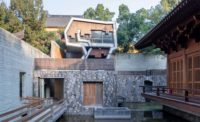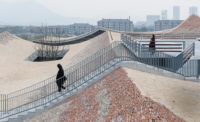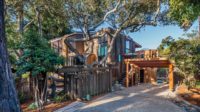Named for the 394-foot-long tile roof that is its most identifying feature, Tiles Hill is the culmination of a dozen years’ work by Amateur Architecture Studio on the Xiangshan Central Campus of the China Academy of Art (CAA) in Hangzhou. A reception center for faculty, visiting professors, and students and their parents, the visually kinetic building is the last of two dozen projects designed by Amateur—the firm run by Pritzker Prize–winner Wang Shu and his wife and partner Lu Wenyu—for the academy at which he serves as head of the architecture department. The collection of dormitories, classrooms, offices, and other academic facilities shows a progressive refinement in the studio’s work from its first building there in 2002. Wang led the design of the project, while Lu took charge of realizing it. “For this final project, I wanted to express my deep understanding of the Chinese spirit,” say Wang. “Maybe I touched it this time.”
The 67,000-square-foot Tiles Hill is wedged between a wooded hill to the north and a narrow river to the south. Museums by Alvaro Siza and Kengo Kuma, the only new campus buildings not designed by Amateur, are under construction nearby. Tiles Hill contains an eclectic set of uses in four sections that ascend in height from east to west: an intimate tearoom; meeting rooms for 160, 50, and 30 people; a dining room for professors and a restaurant for visitors; and a guesthouse with 28 rooms.
A path meanders through the length of the building, from the entrance on the east to the top of the guesthouse on the west, and takes visitors through a series of open and covered spaces. “You go outside, then inside, outside, inside,” says Wang. “Finally you go to the top of the hill, and you see back.” Other paths cut directly through the width of the building. Additional indirect rambles along tight alleys, bridges, and stairways lead to courtyards, benches, dead ends, or spots for a smoke. From any path, the roof’s intricate wood-and-steel structure marks a striking contrast to walls made of rammed earth, rock, bamboo-finished concrete, and even recycled tile and pottery. The combination of traditional craftsmanship and modern construction makes visitors want to touch and engage with the building.
It may be a cliché to say Tiles Hill feels like a village, but after accidentally happening upon cascading pools of water and pleasantly getting lost, this urbanite felt a true sense of walking through a dense neighborhood. Wang says that the “Chinese spirit” evoked here is like winding your way through a mountain or stepping into a traditional landscape painting. Whether urban or rural, the routes are full of chance sights and meetings. “The building is not about the form or shape: it’s about the discovery,” says Wang. “From one layer to another, it offers surprises.”
Tiles Hill is the first building Amateur has completed since Wang was awarded the Pritzker in 2012. It reuses some of the features that drew attention to his work. Oversized wall cutouts, referencing those in Chinese garden walls, are similar to those used in the Ningbo Tengtou Pavilion for the Shanghai World Expo in 2010. A dominating exposed-structure roof is the centerpiece of the Museum of the Imperial Road in downtown Hangzhou. A walking path on top of the roof is a hallmark of Amateur’s best-known work, the Ningbo History Museum. But the success of Tiles Hill lies less in these big gestures than in its small labyrinthine spaces. As impressive as the project’s large roof is, it is upstaged by the multilayered show beneath it.
Amateur’s previous works include complicated interiors encased in big, bold boxes, but Tiles Hill exudes complexity both inside and out. It would be simplistic to say that the new building marks a move from iconic to contextual design for the firm. Tiles Hill’s program calls for a different approach than that for a museum or pavilion. But one can only hope that the serene intricacy of this project finds a voice in Amateur’s future work, including the 420,000-square-foot museum in the Fuyang District of Hangzhou that is in design and should be completed in roughly three years.






















Post a comment to this article
Report Abusive Comment